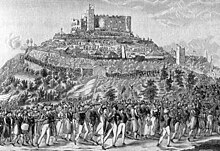Erhard Joseph Brenzinger
Erhard Joseph Brenzinger (born April 7, 1804 in Tiengen , † June 16, 1871 in Mannheim ) was a German history and portrait painter , drawing teacher and museum man.
Life
Erhard Joseph Brenzinger was born on April 7, 1804 in Tiengen near Waldshut as the 13th and last child of the Schwarzenberg administrative officer Benedict Kaspar Brenzinger and his wife Maria Magdalena Geiger.
After graduating from high school in Freiburg im Breisgau , Brenzinger began studying art in Mannheim as a master student of Franz Joseph Zoll . During this time he made friends with the later Baden politician and finance minister Karl Mathy , of whom he made a first miniature portrait in 1827. On November 4, 1828, on a written recommendation from Ignaz Heinrich von Wessenberg, he enrolled at the Academy of Fine Arts in Munich and focused on history painting with Peter von Cornelius . In 1829, as a student of the academy, Brenzinger took part in the art exhibition of the Royal Bavarian Academy of Fine Arts in Munich with the oil painting "Maria with the Child".
In 1832 Brenzinger moved back to Baden and took part in the Hambach Festival with his friends Friedrich Daniel Bassermann , Mathy and Alexander von Soiron . He processed the impressions in his pen-and-ink lithograph “The Train to Hambach Castle”, which was first published as a supplement to the magazine “Der Zeitgeist. Volksblatt für Deutschland ”, edited by Karl Mathy, was published. In addition to history painting, which soon faded into the background, Brenzinger switched to portrait painting and copying of old masters. A three-year study visit to Paris followed in 1835 . The most important work by Brenzinger from this period is a portrait of the Louvre gallery.
Due to a precarious income situation, Brenzinger decided to go to school on the advice of Karl Mathy. From 1840 Brenzinger taught as a drawing teacher at the trade school in Waldshut. Brenzinger married Auguste Mathy, the sister of his friend Karl, on April 29, 1840 in Waldshut.
In 1843 Brenzinger moved again to Mannheim and initially taught various subjects at the local community school before he specialized entirely in drawing lessons. An application for the position of Mannheim gallery director was unsuccessful in 1848. Even with his work "Hauensteiner Baptism" from 1856, success did not come. Brenzinger was involved in the Mannheim antiquity association of 1859 , which he had co-founded, as an expert. As the last artistic achievement Brenzinger made a draft for a vedute of Mannheim from a bird's eye view. Brenzinger died on June 16, 1871 in Mannheim.
Meaning of Brenzinger
- Versions
Brenzinger's work has largely been forgotten despite its painterly quality. His etching "The train to Hambacher Schloss", which shows his friends Bassermann, Mathy and von Soiron in the center of the foreground of the train, is currently one of the most famous political representations of 19th century German history.
literature
- Ludwig Mathy: The painter Erhard Brenzinger . In: Mannheimer Geschichtsblätter , Issue 10-12, 1919, Col. 77-83.
- Joseph August Beringer : Erhard Joseph Brenzinger. An artist's story in family pictures . in: Schau-ins-Land 47/50, 1923, pp. 52–69.
- Tino Mager: Brenzinger, Erhard Joseph . In: Bénédicte Savoy, France Nerlich, France (ed.): Paris apprenticeship years. A lexicon for training German painters in the French capital. Volume 1: 1793–1843 , Berlin / Boston 2013, pp. 36–37. ( limited preview in Google Book search)
Web links
- Private genealogical page on Joseph Brenzinger
- Historical Museum of the Palatinate, Speyer: Train to Hambach Castle in 1832
Individual evidence
- ^ New Nekrolog der Deutschen, 11th year, volume 2. 1833, Voigt, Weimar 1835, volume 11, p. 567
- ^ Joseph August Beringer: Erhard Joseph Brenzinger, special edition, Poppen and Ortmann, Freiburg, 1923, p. 6
- ↑ 01441 Erhard Brenzinger, Matrikelbuch 1828 AdBK Munich, accessed on April 20, 2016.
- ↑ Michael Bangert: Image and Faith: Aesthetics and Spirituality with Ignaz Heinrich von Wessenberg, Academic Press, Friborg Suisse, Paulus, Freiburg Switzerland, Kohlhammer Stuttgart, 2009, note 200 p. 47
- ↑ Directory of the art exhibition of the Royal Bavarian Academy of Fine Arts in Munich, 1829, number 37 on p. 6
- ^ Joseph August Beringer: Erhard Joseph Brenzinger, special edition, Poppen and Ortmann, Freiburg, p. 8
- ↑ Joseph August Beringer: Erhard Joseph Brenzinger, special print, Poppen and Ortmann, Freiburg, p. 28
- ^ Joseph August Beringer: Erhard Joseph Brenzinger, special print, Poppen and Ortmann, Freiburg, p. 40
- ↑ Franz X. Vollmer: The dream of freedom: Vormärz and the 48th revolution in southern Germany in contemporary images, 1983, Konrad Theiss Verlag, Stuttgart, ISBN 3-8062-0295-8 , p. 18, Figure 3, p. 17
| personal data | |
|---|---|
| SURNAME | Brenzinger, Erhard Joseph |
| BRIEF DESCRIPTION | German history and portrait painter, drawing teacher and museum man |
| DATE OF BIRTH | April 7, 1804 |
| PLACE OF BIRTH | Tiengen |
| DATE OF DEATH | June 16, 1871 |
| Place of death | Mannheim |



